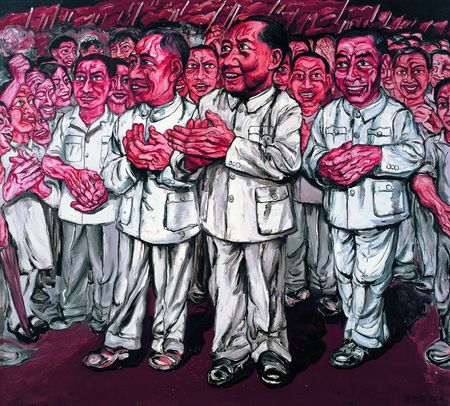Zeng Fanzhi’s From the Masses, To The Masses at the Christie’s Asian contemporary Art Evening Sale
Hong Kong – Christie’s will offer Zeng Fanzhi’s From the Masses, To The Masses at the Asian contemporary Art Evening Sale on November 30th at the Hong Kong Convention & Exhibition Centre.
This pioneering work from the artist is expected to be among the most sought-after offered this season.
In From the Masses, To The Masses (estimate on request) Zeng Fanzhi channels the visual culture of the Communist period, while quietly reworking it based on his own psychological perceptions; it is in this subtle shift away from the programmatic and towards the personal that ushered in the historical emergence of the Chinese contemporary avant-garde. From the Masses, To The Masses is an early work that pre-dates the artist’s famed Mask Series, and here one can begin to see the techniques that would later becomes Zeng’s trademarks – most noticeably using the hands as a means for further exploring a character’s hidden emotions.
The title of the painting, From the Masses, To the Masses, was a core tenet of Chinese political thought promoted by Mao himself, and every aspect of the composition highlights the ideals embodied in the phrase: to be among the masses, to learn from them, in order to lead them - an endless loop of reciprocity and collective self-improvement meant to guide the country to a utopian future. Mao Zedong, appearing at the centre of the canvas, is flanked on either side by Zhou Enlai and Liu Shaoqi, and the together they are leading a seemingly infinite procession of fellow revolutionaries, as evidenced by the dense display of revolutionary flags that fill the horizon. The three main figures, and indeed most of the figures in the composition, look towards the horizon. Taken as a whole, they represent a collective, forward-moving surge of humanity; a celebratory mood dominates, as all the figures applaud and cheer.
The composition and subject matter of the painting are ambitious and evoke the mass-produced images from the early years of the 1960s into the Cultural Revolution. From the Masses, To The Masses is dominated by a luxurious red, typical of many of Zeng’s early canvases but notably different in its usage here. Red was of course the colour of the Revolution, and in accordance with Chinese cultural traditions, the colour also stands as a symbol of prosperity and joy. Zeng’s own artistic technique plays a significant role in deepening the emotional content of the image and distinguishing it from the more polished images this work invokes. While in later works, Zeng might describe facial features hidden by a mask, obfuscating the individual’s real features, here the flesh is in deeply red tones evoking raw meat, further linking the figures into one collective group.
The tendency seen in Zeng’s works towards exaggerating the human figure is subtle in this work, deepening the mood of the canvas. The eyes are only slightly enlarged, emphasizing the crowd’s zealous fervour. All of the figures’ hands are enlarged even further, a tactic employed by the artist to reveal psychological qualities not otherwise revealed by facial expressions. Where in later works, the posture of the hands may reveal contradictory emotions, here they only serve to further unite the figures in their shared goals with their generous and humble gestures accepting applause and returning it, fully embodying the sentiments of the title.
Painted on a grand, larger-than-life scale of the history paintings that Zeng and his contemporaries grew up with and which Zeng himself no doubt would have been trained in, the pageantry of the scene is reminiscent not only of public spectacles of the Communist Party but also the historical paintings of the European tradition. Zeng’s study of German and European Expressionism was influential in his use of caricature as a strategy to reveal essential human characteristics that exist beneath superficial surfaces.
The diverse cultural appeal of Zeng’s art stems from his honesty, fragility and beauty in portraying raw emotions and in expressing his thoughts upon a universally-shared trait: our recurrent desire to aspire to goals beyond our inherent limits and to appear better than we are.

/https%3A%2F%2Fprofilepics.canalblog.com%2Fprofilepics%2F1%2F0%2F100183.jpg)
/https%3A%2F%2Fstorage.canalblog.com%2F03%2F02%2F119589%2F96711876_o.jpg)
/https%3A%2F%2Fstorage.canalblog.com%2F11%2F31%2F119589%2F94773502_o.jpg)
/https%3A%2F%2Fstorage.canalblog.com%2F20%2F83%2F119589%2F94772815_o.jpg)
/https%3A%2F%2Fstorage.canalblog.com%2F26%2F72%2F119589%2F75604929_o.jpg)
/https%3A%2F%2Fstorage.canalblog.com%2F59%2F60%2F119589%2F26458628_o.jpg)



/http%3A%2F%2Fstorage.canalblog.com%2F59%2F26%2F119589%2F127858060_o.jpg)
/http%3A%2F%2Fstorage.canalblog.com%2F70%2F57%2F119589%2F121336635_o.jpg)
/http%3A%2F%2Fstorage.canalblog.com%2F15%2F82%2F119589%2F117802948_o.jpg)
/http%3A%2F%2Fstorage.canalblog.com%2F91%2F83%2F119589%2F112567635_o.jpg)